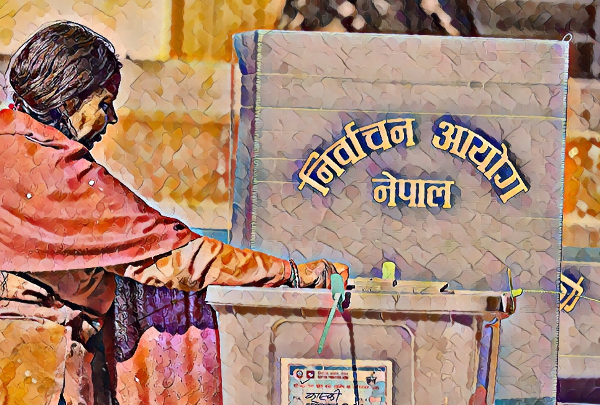Legacy media at a crossroads: Lessons from Nepal's last national election

Photos: Generated by an AI software
Nepal held its last general elections on November 20, 2022, marking the second such event since the adoption of the post-war republican Constitution in 2015.
The elections aimed to select members for the House of Representatives and the seven provincial assemblies, established to implement the federalism outlined in the 2015 constitution.
The Nepali Congress (NC), known as the Grand Old Party, emerged as the largest party, winning 89 of the 275 seats in the lower house. The Communist Party of Nepal Unified Marxist-Leninist (CPN UML) followed as the second largest with 78 seats, while the former rebel Maoists secured 32 seats.
A notable surprise was the rise of the Rashtriya Swatantra Party (RSP), led by Rabi Lamichhane, a controversial ex-television host, which became the fourth largest party with 20 seats.
Additionally, two regional parties gained several seats in the southeastern and southwestern plains.
The 2022 elections were marked by rampant misinformation and disinformation, significantly influencing voter perception and behavior.
False information, including fake endorsements and misleading candidate claims, circulated widely on social media, amplifying confusion among voters.
This spread of inaccurate information swayed opinions and decisions, undermining the electoral process's integrity and presenting a serious challenge as voters relied on misleading narratives about candidates and their policies.
What factors contribute to the prevalence of misinformation in Nepal?
The current state of Nepali media is a blend of traditional and digital outlets navigating a rapidly changing landscape. While essential to democracy, the media faces considerable limitations and vulnerabilities in providing accurate election coverage
Resource constraints, such as inadequate funding and lack of access to modern technology, hinder comprehensive reporting. Political pressures from various groups can result in biased reporting or self-censorship, undermining journalistic integrity.
Additionally, the lack of proper training for journalists exacerbates these issues, leaving them ill-prepared to address the complexities of contemporary election reporting.

Together, these factors create a media environment that struggles to deliver accurate, unbiased, and timely information to the public during critical electoral periods.
During the elections, two incidents underscored the challenges facing Nepal’s news media. Various news outlets reported that re-polling at ten polling stations in Dolakha district on December 1, 2022, had concluded peacefully.
However, social media users shared videos, some of which went viral, alleging that supporters of rival parties clashed on the day of re-voting.
An analysis by Nepal Check, a fact-checking website I edit, revealed that the claim of a peaceful re-poll was only partially accurate.
Supporters of the ruling coalition, which included the Nepali Congress (NC) and Maoists, clashed with members of the opposition CPN UML. Despite this, the national media portrayed the election as peaceful.
Another notable incident involved allegations of voting fraud by former minister and CPN UML candidate Padma Aryal, who was running in Syangja district.
She accused her rival, NC candidate Dhan Raj Gurung, of booth capturing and allowing supporters to cast votes on behalf of others.
Locals indicated that Rupakot, a village in the mountainous region, had a reputation for such practices, including voting on behalf of deceased individuals.
However, the media merely relayed Aryal's accusations without verifying the claims. These instances highlight how Nepal’s news media often fail to investigate election issues thoroughly and uncover a more accurate narrative.
How a new political entity leverage the gap of traditional media
The 2022 elections also saw the rise of new political forces, particularly the Rashtriya Swatantra Party (RSP). The RSP quickly became a significant player in a crowded political landscape, where over 70 parties fielded candidates.
Its emergence was fueled by growing public discontent with traditional political entities. The party effectively utilized digital campaigns, leveraging social media and online platforms to engage voters, especially migrant workers in Gulf countries and Southeast Asia.

This innovative strategy helped the RSP build a strong online presence and mobilize support. However, legacy media were slow to recognize the RSP’s ascent, often underestimating its significance while focusing on established political parties.
This coverage gap reflects the broader challenges faced by traditional media in adapting to new political dynamics and digital campaigning methods.
Another notable outcome of the 2022 elections was the election of Balen Shah, a structural engineer and popular rapper with no prior political experience, as Mayor of Kathmandu.
Shah has emerged as a disruptive figure in Nepali politics, challenging the established dominance of traditional parties. He entered politics with a vision to tackle persistent issues of urban governance and public service delivery in the capital.
His campaign was characterized by strong grassroots engagement and effective use of digital media, which played a crucial role in his electoral success. Shah adeptly communicated his policies, rallied support, and countered the influence of established political entities through these platforms.
His unexpected victory as an independent candidate signifies a significant shift in the political landscape and positions him as a potential contender for higher political roles in the future.
The elections highlighted a clear divide between legacy media and digital media campaigns, showcasing the former's struggle to adapt to the latter's dynamic strategies.
Traditional media outlets, accustomed to covering elections through mass rallies, door-to-door campaigning, and local commentary, found it challenging to keep up with the rapid, targeted, and interactive nature of digital campaigns.
They relied heavily on conventional reporting methods, often missing the nuanced and real-time engagement that digital platforms provided.
Consequently, they were slow to recognize the influence of emerging political forces that effectively utilized social media and online tools to connect with voters.
This shift significantly impacted election outcomes, as digital campaigns proved more adept at mobilizing support, particularly among younger and tech-savvy demographics.
As a result, media predictions based on traditional methods were often inaccurate, highlighting the urgent need for legacy media to adapt to the evolving landscape of political communication.

Why does legacy election reporting need to change?
Traditional election reporting in Nepal has long focused on mass rallies, local commentary, and established political narratives.
In the lead-up to the November 2022 polls, Kathmandu-based reporters descended upon local areas with little understanding of the intricate political dynamics and grassroots issues unique to each region.
This top-down approach often resulted in misreporting or superficial coverage, failing to capture the genuine sentiments of local residents.
For example, many journalists in Kathmandu overlooked the growing discontent in rural areas and the increasing support for independent candidates and new political forces as the elections approached.
This lack of nuanced understanding was apparent in their coverage, which often overlooked critical developments and shifts in voter sentiment. Consequently, this resulted in inaccurate predictions and an incomplete representation of the political landscape.
Challenges such as limited resources, time constraints, and unfamiliarity with local contexts further exacerbated the issue, underscoring the necessity for more localized and informed reporting practices.
The elections underscored several key challenges facing the country's news media, including the proliferation of misinformation, political influence, and the limitations of traditional reporting methods.
To enhance election reporting in the future, Nepali media must invest in digital tools and training that can equip journalists to navigate the complexities of modern political campaigns.
Embracing digital platforms will allow reporters to engage with a wider audience and provide real-time updates, improving their ability to counter misinformation.
Journalists covering elections need a deeper understanding of local political dynamics to ensure accurate and comprehensive coverage. Instead of relying solely on a few local elites for commentary, reporting should encompass the diverse perspectives of the electorate.
—-
Deepak Adhikari is a freelance journalist, researcher and editor based in Kathmandu, Nepal. He currently leads Nepal Check, a fact-checking platform dedicated to exposing misinformation and ensuring the integrity of public discourse in Nepal

